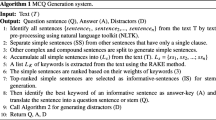Abstract
This paper presents a system which uses Natural Language Processing techniques to generate multiple-choice questions. The system implements different methods to find distractors semantically similar to the correct answer. For this task, a corpus-based approach is applied to measure similarities. The target language is Basque and the questions are used for learners’ assessment in the science domain. In this article we present the results of an evaluation carried out with learners to measure the quality of the automatically generated distractors.
Access this chapter
Tax calculation will be finalised at checkout
Purchases are for personal use only
Preview
Unable to display preview. Download preview PDF.
Similar content being viewed by others
References
Hoshino, A., Nakagawa, H.: Assisting cloze test making with a web application. In: Proceedings of SITE (Society for Information Technology and Teacher Eduation), San Antonio, U.S., pp. 2807–2814 (2007)
Aldabe, I., Lopez de Lacalle, M., Maritxalar, M., Martinez, E., Uria, L.: ArikIturri: An Automatic Question Generator Based on Corpora and NLP Techniques. In: Ikeda, M., Ashley, K.D., Chan, T.-W. (eds.) ITS 2006. LNCS, vol. 4053, pp. 584–594. Springer, Heidelberg (2006)
Sumita, E., Sugaya, F., Yamamota, S.: Measuring Non-native Speakers’ Proficiency of English by Using a Test with Automatically-Generated Fill-in-the-Blank Questions. In: 2nd Workshop on Building Educational Applications Using NLP (2005)
Pino, J., Heilman, M., Eskenazi, M.: A Selection Strategy to Improve Cloze Question Quality. In: Proceedings of the Workshop on Intelligent Tutoring Systems for Ill-Defined Domains (2008)
Mitkov, R., Ha, L.A., Varga, A., Rello, L.: Semantic similarity of distractors in multiple-choice tests: extrinsic evaluation. In: Proceedings of the EACL 2009 Workshop on GEMS: GEometical Models of Natural Language Semantics, pp. 49–56 (2009)
Smith, S., Kilgarriff, A., Sommers, S., Wen-liang, G., Guang-zhong, W.: Automatic Cloze Generation for English Proficiency Testing. In: Proceeding of LTTC conference, Taipei (2009)
Agirre, E., Ansa, O., Arregi, X., Arriola, J.M., Diaz de Ilarraza, A., Pociello, E., Uria, L.: Methodological issues in the building of the Basque WordNet: quantitative and qualitative analysis. In: Proceedings of the first International WordNet Conference, Mysore, India (2002)
Landauer, T.K., McNamara, D.S., Dennis, S., Kintsch, W.: Handbook of Latent Semantic Analysis. Lawrence Erlbaum Associates, Mahwah (2007)
Deerwester, S., Dumais, S., Furnas, G., Landauer, T., Harshman, R.: Indexing by Latent Semantic Analysis. Journal of the American Society for Information Science 41(6), 391–407 (1990)
Gliozzo, A.M., Giuliano, C., Strapparava, C.: Domain Kernels for Word Sense Disambiguation. In: 43nd Annual Meeting of the Association for Computational Linguistics (ACL 2005). University of Michigan, Ann Arbor (2005)
Schütze, H.: Automatic word sense discrimination. In: Computational Linguistics, vol. 24(1), pp. 97–124 (1998)
Turney, P.: Mining the Web for synonyms: PMI-IR versus LSA on TOEFL. In: Flach, P.A., De Raedt, L. (eds.) ECML 2001. LNCS (LNAI), vol. 2167, pp. 491–502. Springer, Heidelberg (2001)
Dorow, B., Widdows, D.: Discovering corpus-specific word senses. In: Proceeding of EACL, Budapest (2003)
Areta, N., Gurrutxaga, A., Leturia, I., Alegria, I., Artola, X., Diaz de Ilarraza, A., Ezeiza, N., Sologaistoa, A.: ZT Corpus: Annotation and tools for Basque corpora. In: Copus Linguistics, Birmingham, UK (2007)
Diaz de Ilarraza, A., Mayor, A., Sarasola, K.: Semiautomatic labelling of semantic features. In: 19th International Conference on Computational Linguistics (2002)
Atserias, J., Villarejo, L., Rigau, G., Agirre, E., Carroll, J., Magnini, B., Vossen, P.: The MEANING Multilingual Central Repository. In: Proceedings of the Second International WordNet Conference-GWC, Brno, Czech Republic, pp. 23–30 (2004)
Zerbitzuak, E.H. (ed.): Elhuyar Zientzia eta Teknologiaren Hiztegi Entziklopedikoa. Elhuyar Edizioak/Euskal Herriko Unibertsitatea (2009)
Agirre, E., Soroa, A.: Personalizing PageRank for Word Sense Disambiguation. In: Proceedings of EACL 2009, Athens, Greece, pp. 33–41 (2009)
Author information
Authors and Affiliations
Editor information
Editors and Affiliations
Rights and permissions
Copyright information
© 2010 Springer-Verlag Berlin Heidelberg
About this paper
Cite this paper
Aldabe, I., Maritxalar, M. (2010). Automatic Distractor Generation for Domain Specific Texts. In: Loftsson, H., Rögnvaldsson, E., Helgadóttir, S. (eds) Advances in Natural Language Processing. NLP 2010. Lecture Notes in Computer Science(), vol 6233. Springer, Berlin, Heidelberg. https://doi.org/10.1007/978-3-642-14770-8_5
Download citation
DOI: https://doi.org/10.1007/978-3-642-14770-8_5
Publisher Name: Springer, Berlin, Heidelberg
Print ISBN: 978-3-642-14769-2
Online ISBN: 978-3-642-14770-8
eBook Packages: Computer ScienceComputer Science (R0)




